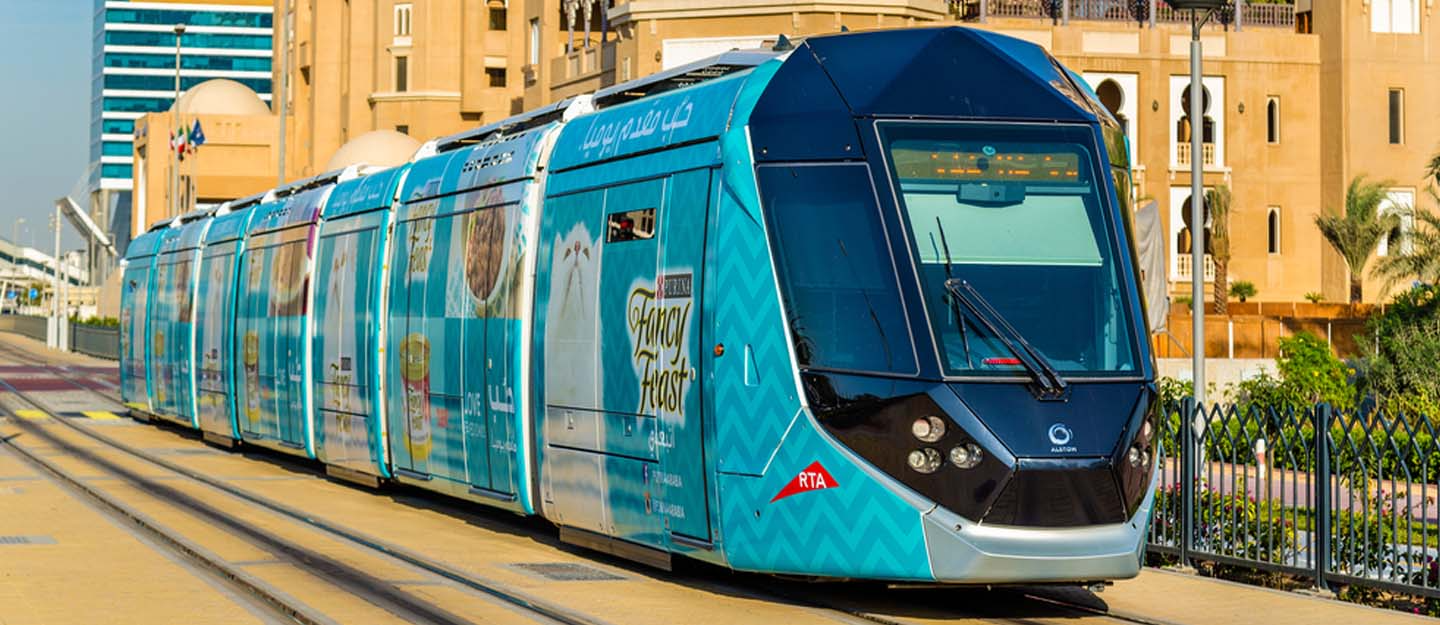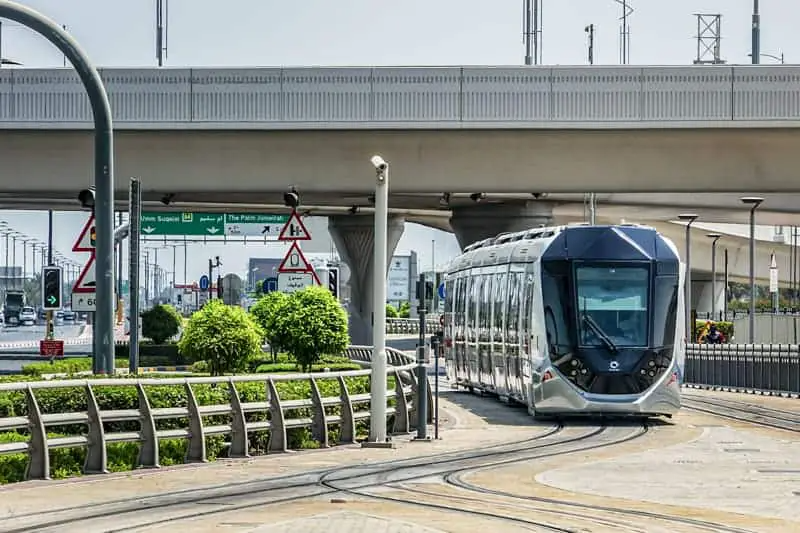A 14.6 km line that primarily follows Al Sufouh Road connects Madinat Jumeirah and the Mall of the Emirates with Dubai Marina and the Jumeirah Beach Residence is the Dubai Tram Project, formerly known as the Al Sufouh Tram Project. Constructed in two stages, it is the first instance of modern tram use in the Gulf area.
Next to the western Dubai waterfront is the district known as Al Sufouh. It has multiple retail centres, and multiple free economic zones, and is connected to the city’s rapidly expanding tourism industry, particularly the Palm Jumeirah development.
The recession caused the project’s first phase to open later than planned in April 2011. Nevertheless, the Dubai Roads and Transport Authority (RTA) subsequently expedited the project, and the tram was formally inaugurated on November 11, 2014, with service commencing the next day.
Initially, the tram would carry 27,000 passengers each day; by 2020, it is anticipated that this number will rise to 66,000.

The project
Included in the UAE, which was established in 1971, are seven states with a high degree of autonomy, each headed by an emir. Dubai is one of these nations. With a focus on transportation, trade, and tourism in particular, Abu Dhabi and Dubai, the largest city in the United Arab Emirates, are promoting the region as a regional hub.
Since oil was discovered in the 1950s, the area has undergone significant change. One aspect of this change has been the application of petroleum income to diversify the economy to attain stability and long-term prosperity.
Numerous construction projects created a need for labour, which quickly increased the population. By the end of 2006, the population had grown by 292,000 to 1.42 million, with almost 75% of them being foreigners. Such rapid growth has led to severe traffic-related issues like lengthy travel times, a high accident rate, and pollution.
According to a government official from 2007, the cost of congestion is equivalent to 3.15% of GDP. If the rate of vehicle growth is allowed to continue, there will be more than five million registered cars by 2020, with the majority of their impact being felt in urban areas.
To address the problem, the RTA started by expanding and renewing its fleet of buses and adding low-emission cars for use in taxi services. The RTA Metro system, which would bring light rail travel to Dubai, is scheduled to start charging for service in late 2009.
Since 2004, MVA Consulting and its parent firm Systra have been involved in the planning of public transport in Dubai; the Metro project being the main rail result. It was suggested that the district use the tram mode to accommodate the demand from tourists and commuters for closely spaced stops. Additionally, it will expand RTA’s coverage for trips using just public transportation.
First revealed in April 2008, RTA and the ABS consortium agreed to a €550 million contract in June for the first phase of the project’s delivery. The construction company Besix from Belgium, the multi-sector operator Serco from the UK, and Alstom from France make up ABS, accounting for almost €300 million of the total.
Line routes
The first phase of the project is a 10.6-kilometer track that runs from Dubai Marina to the Tram Depot close to the Dubai Police Academy, passing via Jumeirah Beach Road, Dubai Knowledge Village, Dubai Media City, and Dubai Internet City. With a normal platform length of 45 metres, it features seven stations at grade and four elevated stations.
A 4-kilometre track connects the line to the Dubai Metro station at Mall of the Emirates in phase two.
Infrastructure
Al Sufouh is the first open tramway in the world with full air conditioning since all of its stations are lined up with platform screen doors. In typical temperatures of around 40°C, air conditioning increases customer appeal and provides consistency with other RTA modes, such as bus shelters. The utilisation of Alstom’s catenary-free APS (Alimentation Par le Sol) system for the continuous ground supply of power to trams while they are overhead is another innovation.
This is the first full system application, even though APS has been in operation since 2003 on certain Bordeaux tramway portions and is defined for other French cities like Angers, Reims, and Orléans. Similar to the specification of third-rail pick-up for Dubai Metro, the authorities wanted to stay away from overhead line equipment that is deemed visually invasive.
There is a minor raised track near the Marina, mostly at surface level. The Damac Properties and Jumeirah Lakes Towers pedestrian bridges connect to the Metro Red Line at two stops, promoting the usage of public transit generally. At the foot of the Palm Jumeirah island on Sufouh Street, Station 9 links to the Palm Jumeirah Monorail.
Along with the 25 tram-trains, an operation control centre, maintenance workshops, garages, retail spaces, and administrative buildings were also constructed as part of the 11-building depot.
The tram riders are served by four covered, air-conditioned footbridges equipped with escalators. Al Sufouh Street is crossed by two bridges that give access to both sides of the street, and two more bridges connect the Tecom district to the other side of the street and the Dubai Marina Mall.
Rolling stock
Alstom provided 25 100% low-floor Citadis 402 trams equipped with APS. Phase one involved the ordering of 11 trams in total; phase two will see the entry of the remaining 14 trams into operation. This 44-meter version, which has seven modules, is in use on the Paris T3 line, where it can accommodate little more than 300 passengers, as well as in Bordeaux with APS equipment and overhead supplies in Grenoble and Strasbourg.
The Al Safouh project has a capacity of more than 5,000 passengers per hour in each direction. Each train has 408 passenger capacity and has cabins designated for women and children in addition to gold and silver cabins.

The trains travel at an average commercial speed of 20 km/h and are powered by a contemporary ground cable system. The Dubai Tram is the first tram outside of Europe to run entirely on ground-electric wires rather than catenary cables.
Modern, tropicalized technology is installed on the trains to survive the severe weather of the area, which includes temperatures above 50°C, 100% humidity, and a sandy atmosphere.
Communications and signalling
Alstom provided the ticketing and signalling system, as well as the control centre that was built into the depot. Alstom’s communication-based train control (CBTC) system, Urbalis, was installed on the trains and the network.
FAQs
How often do trams run?
Trams arrive every 10 minutes during peak hours and every 12 minutes outside of that time.
When are trams operating?
Except on Fridays, when they begin at 9 AM, trams operate from 6:30 AM to 1:30 AM.
How many stations are there?
There are 11 trains and 13 stations on the Dubai Tram.
How can I make a payment?
The tram accepts Nol cards as payment. If you do not possess a Nol card, tickets can be purchased at the tram stops.
How do I plan my trip?
By inputting your starting and destination points, you can plan your trip on the RTA website.
Do I need to tap out for the metro?
Yes, to transfer from the tram to the metro, you must tap out. If you make the transfer within thirty minutes, there won’t be any further fees.

